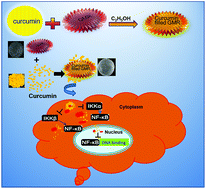Imaging and curcumin delivery in pancreatic cancer cell lines using PEGylated α-Gd2(MoO4)3 mesoporous particles
Abstract
Mesoporous particles are emerging as multifunctional biomaterials for imaging and drug delivery in several disease models, including cancer. We developed PEGylated α-Gd2(MoO4)3 marigold flower-like mesoporous particles for the purpose of drug delivery and, more specifically, evaluated their ability to deliver curcumin. The obtained mesoporous particles significantly conjugated the curcumin particles on their surfaces by inducing the formation of curcumin nanoparticles. In vitro studies of the PEGylated mesoporous particles filled with curcumin demonstrated that these particles could considerably facilitate the continuous and sustained release of curcumin into the cytoplasm and nucleus. As a result, the intracellular release of curcumin can inhibit proliferation in two human pancreatic cancer cell lines: MIA PaCa-2 and PANC-1. Additionally, the particles showed the increased inhibition of pIKKα, pIKKα/β and NF-κB–DNA binding activity as compared to pure curcumin. The curcumin conjugated mesoporous particles are concentrated in the cytoplasm and nucleus of the treated cancer cell lines. Consequently, these mesoporous particles are an effective method for drug delivery that can cross the biological barriers of the body targeting the cellular nucleoplasm.


 Please wait while we load your content...
Please wait while we load your content...